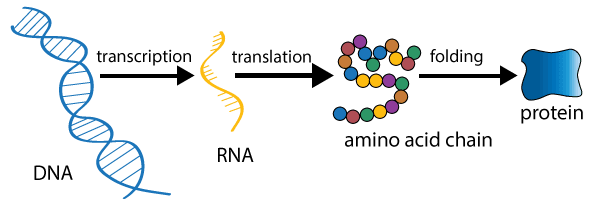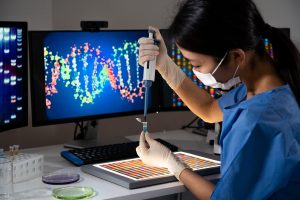What is gene therapy and can it help people with Parkinson’s?
You may have read about efforts to use gene therapy as a treatment for Parkinson’s disease (PD). It’s an exciting prospect and studies are underway, with some positive results so far. Understanding these studies and therapies requires some background information about what genes are and how they work, so I’ve included a glossary below. You might find it helpful to get familiar with the terminology before reading the rest of the article.
The promise of gene therapy
Gene therapy is a category of treatments that involve introducing DNA into cells in an effort to alter which proteins are created and thereby improve symptoms or even cure disease.
For decades, researchers have been trying to perfect gene therapy treatments for a variety of conditions. There have been successes for certain rare genetic disorders which are characterized by a single, well-described mutation in a particular gene. In this situation, a healthy gene is introduced into the cells of these patients. The cell’s machinery then uses the healthy gene to create a healthy protein, which can effectively cure the patient. Diseases that have been helped in this manner include severe combined immune deficiency, adenosine deaminase deficiency, and hemophilia.
It is much more difficult to attempt gene therapy for diseases that involve more complicated DNA changes, such as Parkinson’s disease. Nevertheless, there has been much effort and some success in using gene therapy techniques to treat cancer, for example, a very complex disease which typically involves many genetic changes.
How gene therapy works
A virus is a tiny bundle of nucleic acid that is able to penetrate a cell and hijack the cell’s machinery to replicate its own nucleic acid as well as produce viral proteins, often causing disease in the process. Certain viruses are even able to incorporate their own genetic material into the genetic material of the cell that they infect. Scientists cleverly take advantage of these processes to drive gene therapy. The harmful pieces of DNA are removed from the virus and the gene of choice is incorporated into the viral structure. Then the modified virus is injected into a specific part of the body, thereby allowing it to “infect” cells. If all goes according to plan, the piece of DNA that was introduced into the modified virus is used by the cell’s machinery to make the protein of choice. Adeno-associated virus or AAV is a common virus to use for gene therapy as it typically does not cause symptoms in and of itself when it is introduced into the cell.
ASO, a related strategy to gene therapy
A related strategy which can be thought of as the opposite of gene therapy is called antisense oligonucleotide (ASO). Whereas the goal of gene therapy is to increase the cell’s ability to create a protein of choice, in this therapy, a molecule that blocks the creation of a particular RNA is introduced into the brain, with the goal of decreasing the protein of choice.
Gene therapy for Parkinson’s disease
There have been a number of gene therapy strategies utilized in clinical trials over the years. The strategies fall into a few major categories:
Increasing dopamine production
- Aromatic amino acid decarboxylase (AADC) is an enzyme important in the conversion of levodopa to dopamine and the decline of AADC in the PD brain may be responsible for the changes in efficacy of long-term levodopa treatment. A gene for AADC was introduced into the putamen in the brains of patients with PD. The goal was to increase the amount of AADC present, thereby making levodopa treatment more effective.
- Tyrosine hydroxylase, Guanosine triphosphate cyclohydrolase, and Aromatic amino acid decarboxylase (TH-GCH-AADC) are three enzymes important in the synthesis of dopamine. Genes for all three enzymes were introduced into the putamen of patients with PD, with the goal of increasing dopamine production.
Supporting the survival of dopamine neurons
- Neurturin (NTN) and Glial derived neurotrophic factor (GDNF) – Neurturin is a protein that is a member of the GDNF family of nerve growth factors. A gene for Neurturin was introduced in different brain regions in patients with PD, with the goal of supporting the survival of neurons.
GAD gene therapy: Resetting abnormal brain circuitry
- Glutamic acid decarboxylase (GAD) is an enzyme that increases the production of a brain chemical called gamma-aminobutyric acid or GABA. A gene for GAD was introduced into the subthalamic nucleus in the brains of patients with PD. The goal was to increase the presence of GABA in that brain area, thereby helping to reset the abnormal circuitry of the Parkinson’s brain.
Counteracting genetic mutations that contribute to PD risk
- Glucocerebrosidase (GBA) – A subset of people with PD carry a mutation in the GBA gene, which when working correctly, helps to break down cellular products that can be harmful to the cell. Gene therapy introduced the normal GBA gene into the brain.
- Leucine-rich repeat kinase 2 (LRRK2) – A subset of people with PD carry a mutation in the LRRK2 gene, which when working properly, adds phosphate groups onto other proteins. Mutations in LRRK2 that cause PD increase the activity of LRRK2. Therefore, one approach to treatment was to introduce a molecule that binds the messenger ribonucleic acid (mRNA) of LRRK2 to inhibit its translation into a protein.
In general, the published trials of these compounds have shown that they are safe and some have demonstrated modest improvements in functioning. Gene therapy trials for PD and their results are discussed in this NIH research review. Larger trials for all these approaches are necessary however, before they are approved for clinical use. A number of trials are currently underway.
Current gene therapy/antisense oligonucleotide trials for PD include:
- A Study of AAV2-GDNF in Adults With Moderate Parkinson’s Disease (REGENERATE-PD) – The objective of this randomized, surgically controlled, double-blinded, Phase 2 study is to evaluate the safety and efficacy of AAV2-GDNF delivered to the putamen in subjects with moderate Parkinson’s disease.
- A Double-blind Study to Evaluate the Safety of Glutamic Acid Decarboxylase Gene Transfer in Parkinson’s Participants The objective of this clinical trial is to evaluate the safety and tolerability of adeno-associated virus (AAV)-mediated delivery of glutamic acid decarboxylase (GAD) gene transfer into the subthalamic nuclei (STN) of participants with Parkinson’s disease.
- Phase 1/2a Clinical Trial of PR001 (LY3884961) in Patients With Parkinson’s Disease With at Least One GBA1 Mutation (PROPEL) – This is a first in human, open-label, ascending dose study to evaluate the safety of administration of the normal GBA gene in patients with moderate to severe Parkinson’s disease with at least one pathogenic GBA mutation.
- A Study to Evaluate the Safety, Tolerability, and Pharmacokinetics of BIIB094 in Adults With Parkinson’s Disease (REASON) – The objective of this study is to evaluate the safety, tolerability, and pharmacokinetics of single and multiple doses of BIIB094 administered via intrathecal (IT) injection to participants with Parkinson’s disease. The study is open for PD patients with verified presence or absence of variations in the leucine-rich repeated kinase 2 (LRRK2) gene, but also for patients without any verified PD-related genetic variant.
What is the future of gene therapy for Parkinson’s disease?
The future of gene therapy is very exciting, and we await the results of the current studies. APDA will update you when the results are unveiled.
Tips & Takeaways
- There are multiple gene therapy strategies which are currently being studied in clinical trials. Each has promising data behind it and additional studies are underway.
- If you are interested in joining a gene therapy clinical trial, keep your eye on clinicaltrials.gov to see if there are any that are recruiting patients. If you find one that interests you, talk with your neurologist about your suitability for such a trial.
Gene Therapy Glossary
Nucleotides: the molecules that serve as the building blocks for DNA and RNA
Oligonucleotide: a short string of nucleotides
DNA: Stands for deoxyribonucleic acid – large molecules consisting of two chains of nucleotides strung together and coiled to form a double helix shape. The molecule can replicate itself and contains biological information to make proteins needed for every aspect of life
Gene: a region of DNA that is used as a template to create a protein that influences biological function
Mutation: a change, often heritable, in one or more nucleotides within a gene that can affect the production of a protein
RNA: Stands for ribonucleic acid – molecules that transfer information from the DNA and facilitate the creation of protein molecules
Protein: molecules consisting of a string of amino acids which are synthesized using the code embedded in DNA


